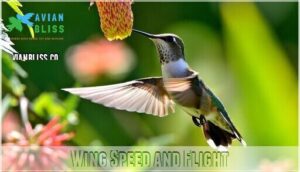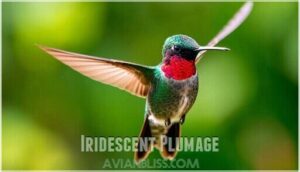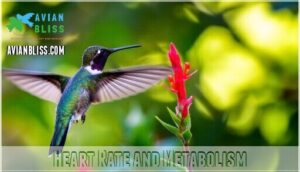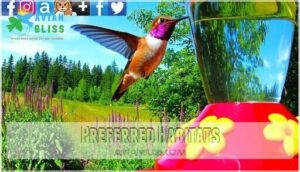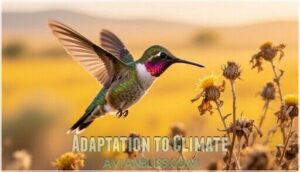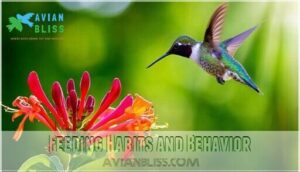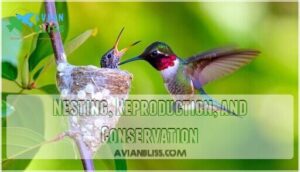This site is supported by our readers. We may earn a commission, at no cost to you, if you purchase through links.
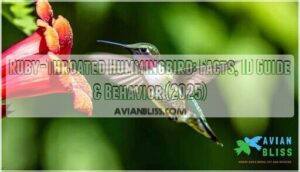
These sparrow-sized birds weigh less than a nickel but pack serious attitude, hovering at flowers with wings beating 53 times per second.
They’re North America’s most common hummingbird, found from southern Canada to the Gulf Coast during breeding season.
Males defend feeding territories aggressively while females focus on raising chicks in spider silk-lined nests.
Their incredible migrations span up to 2,500 miles, including nonstop Gulf crossings that seem impossible for such delicate creatures.
These aerial acrobats can fly backward, upside-down, and maintain heart rates over 1,200 beats per minute during flight with serious attitude.
Table Of Contents
- Key Takeaways
- Ruby-throated Hummingbird Identification
- Physical Traits and Unique Features
- Habitat, Range, and Migration
- Feeding Habits and Behavior
- Nesting, Reproduction, and Conservation
- Frequently Asked Questions (FAQs)
- How to identify a ruby-throated hummingbird?
- How to find a ruby-throated hummingbird nest?
- What’s the lifespan of a ruby-throated hummingbird?
- Do ruby-throated hummingbirds migrate in pairs?
- Whats the average lifespan of a ruby-throated hummingbird?
- How often do ruby-throated hummingbirds feed?
- Do ruby-throated hummingbirds sing?
- Are ruby-throated hummingbirds territorial?
- How long do ruby-throated hummingbirds live?
- What predators threaten ruby-throated hummingbirds?
- Conclusion
Key Takeaways
- You’ll identify males by their brilliant ruby throat patch that flashes red in sunlight, while females have white throats – both species show emerald-green backs and weigh less than a nickel.
- You’re watching nature’s most incredible migrants – these tiny birds fly up to 2,500 miles twice yearly, including nonstop 500-mile Gulf of Mexico crossings in under 24 hours.
- You’ll need to provide consistent food sources since they feed every 10-15 minutes and consume half their body weight daily in nectar, making feeders and native flowers essential.
- You’re supporting fierce territorial defenders who’ll aggressively chase away intruders from their feeding areas, with males performing dramatic diving displays during breeding season.
Ruby-throated Hummingbird Identification
Identifying a ruby-throated hummingbird becomes easier once you know what to look for in North America’s most common hummingbird species.
You’ll spot these tiny birds by their emerald-green backs, distinctive throat colors, and rapid wing beats that create a characteristic buzzing sound.
Size and Shape
You’ll instantly recognize this tiny jewel by its sparrow-sized dimensions and compact build.
At just 3-3.5 inches long with a 4-inch wing span, ruby-throated hummingbirds pack remarkable features into their petite frames.
Their slender, slightly curved bill length reaches 2 centimeters, while their short wings don’t extend past the tail when perched.
Body size averages 2-6 grams in weight.
Understanding bird size categories is essential for accurate identification of these small birds with remarkable features and petite frames.
Color Pattern
When sunlight hits the ruby throated hummingbird’s plumage, you’ll witness nature’s living jewel in action.
These tiny iridescent jewels flash like living emeralds and rubies in sunlight
The iridescent feathers create a dazzling display that shifts with every movement and angle.
Here are the key color patterns you’ll observe:
- Ruby throat (gorget) – Males display brilliant red that flashes like fire
- Green back – Metallic emerald sheen covers the upper body
- White underparts – Clean, bright coloring beneath the wings
- Iridescence – Colors appear to change from black to brilliant hues
- Throat patch – Females show pale coloring instead of ruby red
Male Vs Female Differences
Two key features separate male and female ruby throated hummingbirds through sexual dimorphism.
Males sport that iconic ruby throat patch that flashes brilliant red in sunlight, while females display white throats with subtle streaking.
You’ll notice females are slightly larger, and males show deeply forked black tails versus the female’s rounded, white-tipped tail feathers, which are key identifiers in distinguishing between the two sexes through visual separation.
Immature Birds
Young ruby-throated hummingbirds present unique challenges for bird identification enthusiasts.
Immature males resemble adult females but show shorter bills and smaller overall size during the fledgling stage.
These juveniles lack the distinctive ruby throat patch, displaying white throats with possible faint streaking.
Chick development occurs rapidly, with nestlings ready for young migration within weeks of hatching from their thimble-sized nests.
Key Field Marks
Looking for foolproof ways to identify ruby throated hummingbirds? These Archilochus colubris field marks will make bird identification simple:
- Bill Shape: Straight, needle-thin beak perfect for reaching deep flowers
- Feather Color: Metallic green back contrasts with white underparts
- Tail Length: Males show deeply forked tails, females display rounded tips
- Plumage Pattern: Ruby gorget on males creates unmistakable field mark
Physical Traits and Unique Features
You’ll discover that ruby-throated hummingbirds possess remarkable physical adaptations that make them true marvels of engineering.
Their specialized bill reaches up to 2 cm in length with a tongue that extends twice as far, while wings beat an incredible 53 times per second to power their legendary hovering abilities.
Bill and Tongue Structure
The ruby throated hummingbird’s bill reaches up to 2 centimeters in length, perfectly designed for accessing nectar from tubular flowers.
This straight, slender beak structure houses an extraordinary tongue that extends more than twice the bill’s length, allowing precise nectar access deep within blooms.
| Feature | Specification |
|---|---|
| Bill Length | Up to 2 cm |
| Tongue Extension | 2x+ bill length |
| Feeding Rate | 13 licks/second |
| Daily Consumption | Half body weight |
The feeding mechanism works like a tiny pump, with the specialized tongue structure enabling rapid nectar collection from their preferred red tubular flowers.
Wing Speed and Flight
You’ll witness incredible aerodynamics when watching a ruby throated hummingbird’s flight capabilities.
Their wings beat approximately 53 times per second, creating that distinctive buzzing sound.
These remarkable flight patterns include hovering, backwards flying, and even upside-down maneuvers.
Their feather structure enables precise air speed control, while their compact bird wingspan supports nonstop flight across vast distances during migration journeys.
Iridescent Plumage
Ever wondered what makes ruby throated hummingbird feathers shimmer like tiny jewels?
Their iridescent plumage isn’t from pigments but from microscopic feather structures that create stunning light refraction.
These specialized barbules act like prisms, producing brilliant color patterns that shift with viewing angles.
- Gorget magic: Male’s ruby throat appears black in dim light, blazing red in sunlight
- Feather structure: Microscopic platelets in barbules create prismatic light effects
- Angle-dependent colors: Iridescence changes dramatically based on your viewing position
- Species identification: Green back coloration helps distinguish from other hummingbird species
- Plumage care: Regular preening maintains ideal light-reflecting surfaces for maximum brilliance
Heart Rate and Metabolism
You’ll discover the ruby throated hummingbird possesses nature’s most extraordinary metabolic rate, with heart beats reaching 1,260 per minute during flight.
This incredible energy consumption requires constant nectar feeding to fuel their caloric burn and oxygen intake.
Their hummingbird metabolism operates like a high-performance engine, making ruby-throated hummingbird courtship displays possible through sustained hovering and rapid aerial maneuvers.
Leg Structure and Perching
Unlike most birds that grip branches tightly, ruby throated hummingbird leg structure reveals fascinating adaptations for their unique lifestyle.
Their tiny leg bones and specialized foot shape enable quick perching between feeding sessions.
Key aspects of ruby-throated hummingbird perching behavior include:
- Delicate leg bones – lightweight hollow structures minimize flight weight
- Sharp claw structure – curved talons grip thin twigs and wire feeders
- Flexible foot shape – three forward toes, one back for secure positioning
- Quick balance techniques – rapid adjustments maintain stability on swaying perches
- Brief perching behavior – short rest periods between territorial flights and feeding
This specialized bird anatomy supports their high-energy lifestyle perfectly.
Habitat, Range, and Migration
You’ll find ruby-throated hummingbirds across eastern North America during breeding season, from southern Canada to the Gulf Coast.
These tiny travelers make an incredible journey twice yearly, flying up to 2,500 miles to winter in Central America and Mexico.
Preferred Habitats
You’ll find ruby-throated hummingbirds thriving in forest edges and open woodlands where flowers meet trees.
These boundary zones offer perfect hunting grounds for nectar and insects.
Garden habitats in suburban areas also attract them, especially yards with native flowers and water sources.
The presence of hummingbird feeders, such as those found in hummingbird feeder selections, can substantially enhance the attractiveness of a garden habitat.
| Habitat Type | Key Features |
|---|---|
| Forest Edges | Mixed sunlight, diverse flowers |
| Open Woodlands | Scattered trees, clearings |
| Garden Habitats | Feeders, cultivated flowers |
| Suburban Areas | Parks, landscaped yards |
| Boundary Zones | Habitat boundaries, variety |
Breeding and Wintering Range
Ruby-throated Hummingbirds showcase North America’s largest hummingbird breeding range, with distinct seasonal territories that highlight their remarkable adaptability.
Breeding Grounds and Wintering Areas:
- Summer breeding range spans from central Alberta to Nova Scotia, covering Minnesota to Atlantic coastal states
- Primary wintering areas include Mexico and Central America, with some year-round Florida and Gulf Coast residents
- Range expansion shows increasing winter sightings in southern U.S. states, possibly due to climate adaptation
- Habitat preferences favor boundary zones between forest edges and open areas during breeding season
- North American hummingbirds rely on this species’ extensive range for ecological pollination services
Migration Patterns and Distance
Every spring, ruby throated hummingbird migration patterns showcase remarkable endurance as these tiny travelers set out on epic journeys spanning up to 1,600 miles.
Nature’s tiniest marathon runners embark on epic 1,600-mile journeys that defy their sparrow-sized frames
Their hummingbird migration includes nonstop Gulf of Mexico crossings covering 500-600 miles in 18-22 hours—an incredible feat for such small birds.
The birds’ ability to adapt to changing migration route patterns is a key factor in their successful migration.
| Migration Aspect | Details |
|---|---|
| Flight Distances | 1,200-1,600 miles total journey |
| Gulf Crossings | 500-600 miles nonstop |
| Daily Rate | 20-25 miles average |
| Migration Routes | Trans-Gulf or coastal overland |
| Wintering Areas | Mexico to Central America |
Stopover Sites and Challenges
During their epic journeys, ruby-throated hummingbirds face serious challenges at stopover sites.
The Yucatán Peninsula serves as their primary spring refueling station, but autumn migration bypasses this area.
Weather patterns and habitat selection affect their fueling strategies, and cold fronts can force emergency landings during Gulf crossings.
Energy conservation becomes critical when suitable stopover ecology isn’t available for these remarkable migrants, and understanding critical stopover sites is essential for conserving these bird species.
Adaptation to Climate
Climate change is reshaping how ruby throated hummingbirds navigate their world.
These tiny travelers face three key adaptation challenges:
- Migration Timing shifts as spring arrivals occur 11-18 days earlier
- Temperature Tolerance limits push metabolic systems during extreme weather
- Ecosystem Resilience depends on matching flowering plants’ changing schedules
Weather patterns now influence arrival dates more than ever before, testing their remarkable ability to synchronize with nature’s shifting rhythms.
Hummingbirds are experiencing significant challenges due to climate change effects that impact their survival.
Feeding Habits and Behavior
You’ll discover that ruby-throated hummingbirds are remarkable feeding machines with incredibly specialized behaviors.
These tiny birds consume their body weight in nectar daily and display fierce territorial instincts around food sources.
Primary Food Sources
These tiny powerhouses fuel up on nectar sources from tubular flowers, especially red and orange blooms like bee balm and cardinal flower.
Their insect diet provides essential protein, making up about one-third of their calories from gnats, mosquitoes, and spiders. You’ll also spot them at bird feeders sipping sugar water solutions that mimic natural nectar feeding habits.
Understanding bird feeding habits is vital for attracting these birds to your yard, and recognizing their preference for nectar sources can help in creating an inviting environment.
Feeding Techniques and Methods
Ruby-throated hummingbirds use specialized feeding strategies to extract nectar efficiently.
Their forked tongue structure acts like a tiny pump, extending twice the bill’s length to reach deep nectar sources.
You’ll observe three key foraging techniques:
- Rapid licking – Up to 13 times per second at flowers
- Strategic hovering – Precise positioning at hummingbird feeders
- Sugar preference targeting – Favoring red tubular blooms and sugarwater solutions
Understanding vital hummingbird feeder placement is essential for attracting these birds.
Territoriality and Aggression
These tiny warriors turn into fierce defenders in regards to their feeding territories.
Ruby throated hummingbird males patrol flower patches and feeders like mini bouncers, diving and jabbing at intruders with surgical precision.
Territorial defense creates intense feeder wars where aggressive behavior establishes clear dominance hierarchies.
Even females show territorial aggression during peak feeding times, proving that size doesn’t determine fighting spirit in border patrol battles.
Hovering and Flight Maneuvers
Watch a ruby throated hummingbird perform incredible aerodynamic feats that seem to defy physics.
Their hovering techniques involve beating wings 53 times per second, creating figure-eight patterns that generate lift on both strokes.
These flight speed masters execute three remarkable air maneuvers:
- Forward and backward flight at speeds up to 30 mph
- Instant directional changes while maintaining perfect hovering stability
- Upside-down flying during brief courtship displays.
Their hummingbird behavior showcases bird flight capabilities rivaling insects more than traditional birds.
Daily Activity Patterns
Morning feeding kicks off the ruby throated hummingbird’s busy schedule as they consume half their body weight daily.
These tiny dynamos follow strict daily routines, feeding every 10-15 minutes while conserving energy through strategic foraging strategies.
| Time Period | Activity Pattern |
|---|---|
| Dawn-Morning | Peak morning feeding, territorial defense |
| Midday | Reduced activity, energy conservation |
| Evening | Intensive foraging, nocturnal behavior prep |
The hummingbirds’ daily activities are characterized by peak morning feeding, reduced activity during midday, and intensive foraging in the evening.
Nesting, Reproduction, and Conservation
You’ll discover that ruby-throated hummingbirds have fascinating reproduction cycles that begin with spectacular aerial courtship displays and end with tiny chicks ready for their first migration.
Understanding their nesting habits and conservation needs helps protect these remarkable birds for future generations.
Courtship and Mating Displays
Passion ignites the spring air as male ruby throated hummingbirds transform into aerial acrobats.
These courtship displays feature dramatic U-shaped dives, where males plummet toward females before swooping skyward.
Their territorial behavior intensifies during mating rituals, with iridescent gorgets flashing like jewels.
Courtship dances include pendulum swings and chittering vocalizations that declare their romantic intentions to potential mates.
The success of these displays often depends on effective hummingbird mating strategies, including hummingbird mating.
Nest Construction and Location
During breeding season, female ruby-throated hummingbirds construct tiny architectural marvels using remarkable engineering skills.
These thimble-sized nests represent perfect examples of hummingbird nesting efficiency and camouflage techniques.
Key nest construction elements:
- Nest materials – Spider silk, plant down, moss, and lichen create flexible, expandable structures
- Tree selection – Deciduous trees with thin, downward-sloping branches provide ideal support
- Nest height – Positioned 10-40 feet high for protection from predators
- Branch orientation – Built on horizontal or slightly sloping branches for stability
The use of natural bird nest materials is essential for the survival and success of these nests.
Parental Care and Chick Development
Once the chicks hatch, you’ll see remarkable parental behavior from the female ruby throated hummingbird.
She feeds them regurgitated nectar and insects every 20 minutes throughout daylight hours.
Chick growth happens fast – they’ll double their weight in just days.
The mother’s fledgling care includes keeping them warm and teaching flight skills before brood survival depends on their independence at three weeks old.
Conservation Status and Threats
You’ll find the ruby throated hummingbird enjoys stable conservation status with over 20 million individuals globally.
However, habitat loss from urbanization reduces nesting sites by 23% in affected areas.
Pesticide exposure decreases feeding rates by 30%, while domestic cats kill 1.4 million hummingbirds annually.
Despite these human impact challenges, bird conservation efforts promote native gardens, reducing collision deaths through window treatments by 67%, which supports the overall conservation efforts.
Impact of Climate Change
Climate change is reshaping ruby throated hummingbird survival in dramatic ways.
Temperature shift and altered weather patterns disrupt migration timing, forcing birds to arrive before flowers bloom.
Sea level rise threatens coastal stopover sites, while ecosystem disruption breaks centuries-old partnerships between hummingbirds and plants.
These climate change impacts challenge bird adaptation to climate change, making survival increasingly difficult.
Frequently Asked Questions (FAQs)
How to identify a ruby-throated hummingbird?
Like a living jewel suspended in air, you’ll spot males by their brilliant ruby-red throat patch that flashes like a traffic light.
Look for tiny green backs, white bellies, and rapid wingbeats creating that signature buzz.
How to find a ruby-throated hummingbird nest?
Look for tiny, well-camouflaged nests on thin horizontal branches, usually 4-20 feet high. They’re thimble-sized, made with spider webs and lichen, often near water sources in gardens or woodland edges.
What’s the lifespan of a ruby-throated hummingbird?
You’ll witness these tiny aerial acrobats live roughly 3-5 years in the wild, though their intense lifestyle means many don’t make it past their first challenging migration journey south.
Do ruby-throated hummingbirds migrate in pairs?
No, ruby-throated hummingbirds don’t migrate in pairs or flocks.
These tiny travelers fly solo during their incredible journeys, including nonstop Gulf of Mexico crossings.
Each bird navigates independently using internal compasses guided by sun and stars, which is an essential aspect of their incredible journeys.
Whats the average lifespan of a ruby-throated hummingbird?
You’ll find these tiny birds typically live 3-5 years in the wild, though some lucky individuals can reach 6-9 years with ideal conditions and minimal predation pressures.
How often do ruby-throated hummingbirds feed?
Like clockwork, you’ll watch these tiny powerhouses feed every 10-15 minutes throughout the day.
They consume up to half their body weight in nectar daily, requiring 5-6 feeding sessions per hour to fuel their lightning-fast metabolism.
Do ruby-throated hummingbirds sing?
You’ll hear chirps, squeaks, and chattering sounds from these tiny birds, but they don’t truly sing like songbirds. Their vocalizations consist of simple calls for communication and territorial defense.
Are ruby-throated hummingbirds territorial?
Males defend their territory with surprising intensity—they’ll chase away birds ten times their size.
Yes, you’ll witness fierce territorial behavior, especially during breeding season when males fiercely guard flowers and feeders by jabbing competitors with their razor-sharp beaks.
How long do ruby-throated hummingbirds live?
Ruby-throated hummingbirds typically live 3-5 years in the wild, though some reach 9 years.
You’ll find their lifespan depends on surviving harsh migrations, predators, and finding adequate food sources throughout their range, which is crucial for their surviving.
What predators threaten ruby-throated hummingbirds?
In a million dangerous ways, these tiny warriors face constant threats that’d shock you.
Hawks, cats, praying mantises, spiders, snakes, and larger birds hunt them relentlessly, while you’re watching your feeders, unaware of nature’s brutal game.
Conclusion
Throughout your backyard, a tiny emerald jewel might hover just three feet away, its ruby throat catching sunlight like a living gem.
This ruby throated hummingbird represents nature’s perfect balance of power and delicacy.
You’ve discovered a creature that defies physics with backward flight, conquers impossible migrations, and maintains territories with fierce determination.
Whether you’re identifying males by their brilliant throat patches or watching females construct spider silk nests, these remarkable birds offer endless fascination.
Keep your feeders filled and gardens blooming—you’re supporting one of North America’s most extraordinary aerial athletes with a delicate touch of backward flight.
- https://www.audubon.org/magazine/10-fun-facts-about-ruby-throated-hummingbird
- https://www.nwf.org/Educational-Resources/Wildlife-Guide/Birds/Ruby-Throated-Hummingbird
- https://journeynorth.org/hummingbirds/resources/article/how-many-miles
- https://northernwoodlands.org/articles/article/hummingbird-north
- https://abcbirds.org/bird/ruby-throated-hummingbird/


